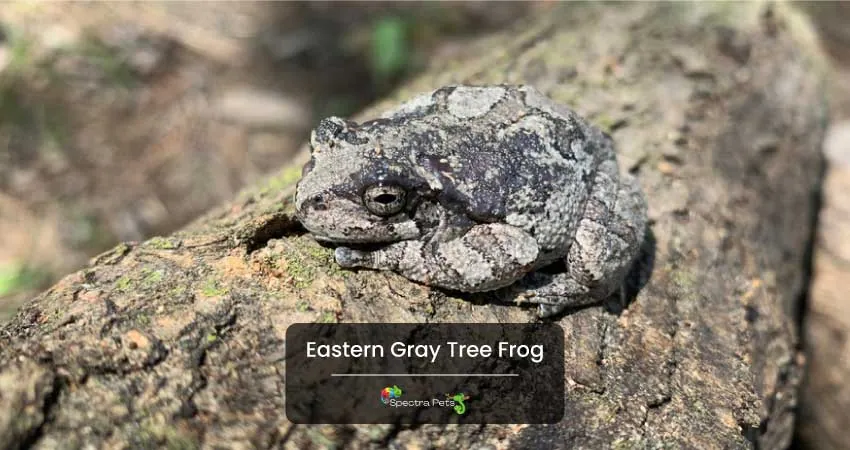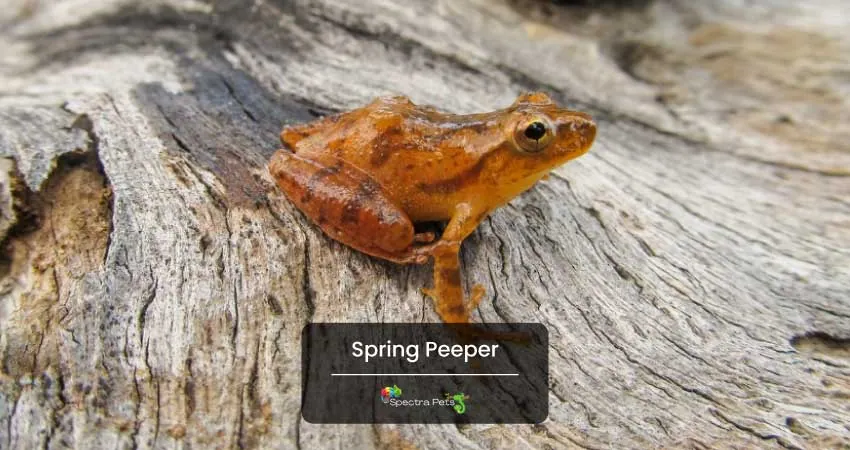Most people think of Massachusetts as the place of Universities while the wider biodiversity makes it home for tree frogs.
Though you will find only 2 species of tree frogs, their impact is immense & their numbers are constantly growing.
Massachusetts is the sweet home of Eastern Gray tree frogs & Spring peepers.
In this short post, you will acquire in-depth knowledge of these frogs as I will share the diet, lifespan, breeding season, calling sound, size, and natural habitat.
So let’s not waste time and dive into the main topic.
1. Eastern gray tree frog

Living in varieties of habitats, the gray tree frog is one of the most common tree frogs in the USA. They are distributed in places like Massachusetts, Tennessee, Alabama, Ohio, Maine, Texas, Florida, etc.
As they are gifted with sticky toe pads, getting on & off trees is no issue for them. Along with that, they are the biggy in the Hildae family & size can vary from 1.25″- 2.25″.
When it comes to the habitat, they prefer woodland forests and swamps that are near shallow water bodies. One thing is compulsory for their comfort and that high-level moisture.
They just love eating moths, tree crickets, ants, grasshoppers, snails, and plant lice. plus, their cannibalistic instinct assists them to consume smaller frogs in their habitat.
Before the breeding season, the male frog gets into temporary water pools, stagnant water, roadside ditches, weedy ponds, etc. These cuties become sexually mature around 2 years old.
As soon as April begins the male starts calling out the top female with loud & repeated calls to attract the female. Breeding season stays up until August month. However, these critters can emit their melodic sound even outside of mating season on warm, ultra-humid, or heavy rainy days.
During the mating time, the male becomes super aggressive and they get into fighting with another male frog over the territory and female partner.
Following a perfect mating, the female lays the eggs on surface water. The total amount of eggs can be around 2000.
If you look at the lifespan, these are indeed one of the longest-living tree frogs blessed with 7-9 years in the wild. The color can be greenish-gray, black, gray, or brown. Adding to that, these bumpy skin frogs have a light skin hue during the night & dark dorsal color during the day.
Besides, these magnificent creatures easily survive the freezing temperatures as they get into hibernation mode. They make glycerol inside their body which keeps them going on with a very low metabolic rate.
2. Spring peeper

This vibrant color frog has an impressive population spreading over states like Massachusetts, Oklahoma, Michigan, Texas, Florida, etc. Due to their top-notch hibernation ability, these frogs pass the winter without any sort of difficulty. Places like tree holes, soft mud, and under-tree logs are their favorite spots for the winter season.
Similar to other tree frogs, their diet is filled with insects like ants, spiders, flies, beetles, etc. The time for hunting food has a big difference between adult & young frogs. Throughout the morning and afternoon, the young ones search for food while the adult ones hunt insects right before the evening.
Plus, the dorsal color of the Spring peeper is available in brown, reddish, grey, tan, and green shades.
Speaking of their predators, snakes, salamanders, large spiders, and birds of prey will rank in the first row. However, the outstanding jumping skill of the frog helps them to evade predators quite often.
For optimum body function & comfort, they look for zones that are packed with high-level moisture. Which includes places like grassy lowlands, woodland close to vernal pools, swamps, and fishless ponds.
Despite the heavy destruction of their home, this wonderful species is listed as the least concerning amphibian. In wild, these cuties can survive up to 3-4 years & reach sexual maturity around 2-3 years old. A full-grown frog of the Hylidae member grows up to 1.5″ in length.
Whenever the mating season enters, the male produces a loud trill that repeats about 20 times in 60 seconds. Louder the trill means a higher chance of getting the female in a short time. For searching for food or roaming around, they can travel 20 -130 feet every single day.
Furthermore, they play a critical & beneficial role in the ecosystem by hunting down lots of insects. For breeding, they choose spots like wet meadows, fishless ponds, shallow ponds, seasonal pools, flooded ditches etc.
Final words
Hopefully, so far you enjoyed reading the article where I tried to give you a bit idea about the local tree frogs.
Though you didn’t become an expert, surely you have more information inside your mind than most of the amphibian lovers around you.
If this article gives you the spark to know about frogs and explore the hidden side of their existence that’s what makes each wording meaningful.
Tree Frogs Found in the Nearby States of Massachusetts:
